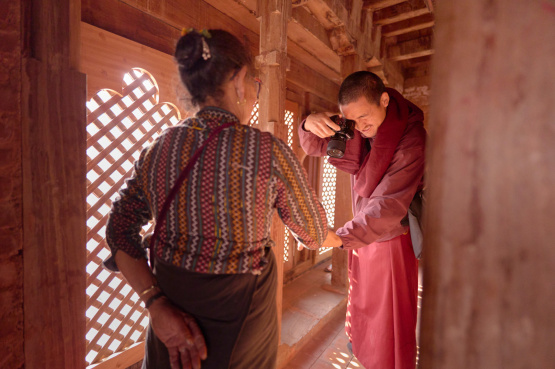Thousands of people a day journey to Agra for one reason alone, to see the Taj Mahal with their own eyes. It is one of those places the lives up to the hype, a remarkable piece of architecture born of a Mughal Emperor's love for his departed wife. Shah Jahan, the grandson of Akbar the Great, spent 22 years constructing the Taj Mahal so that the body of his beloved could rest eternally in a setting befitting her own beauty.
Little could he have imagined the sprawling city of chaos that would grow around it, or that the building would become the most visited attraction in all of India. As I walk out of my hotel in Agra there are five rickshaw drivers yelling out to win my business, "You want to see the Taj, I know where it is, I show you Taj!"
Given the chance he'll also show me a dozen rug shops in the hope of picking up a sizable commission and pay for a brand new rickshaw. On my first visit to Agra I watched a fellow traveller max-out her credit cards to ship home a selection of floor rugs worth many times the cost of her tour. Never underestimate an Indian salesman.
Two things I have learned about rickshaw drivers in Agra. Firstly they don't like "No" for an answer, and secondly they wont carry you any further than they absolutely have to. The north gate is usually the closer ride from the good hotels, and it's by far the busiest too. Try asking the rickshaw-wallah to ride around to the south and suddenly his command of English goes missing.
The short walk from the main road to the entrance gates is a gauntlet of overpriced souvenirs, mostly in the form of tacky Taj replicas made from soapstone carvings, tinsel filled snow domes and disfunctional alarm clocks. Why on earth would anyone want a poor copy of such a beautiful masterpiece is beyond me. Snapping a shot on your digital camera will give you a far more faithful image to remember the experience by.
This building is the Jennifer Hawkins of architecture - there are no bad photos of the Taj Mahal.
Getting into the Taj Mahal can be a bit tricky, with 10,000 or more people each day lining up to enter. Before getting in line you need to visit a poorly signed window on the other side of the queues and buy your tickets. Locals are charged $0.25 to enter and tourists $6.
It's pointless to arrive with more than your camera however, as bags are not permitted inside and objects as harmless as mini-tripods, snacks and mobile phones are banned. If you're carrying a video camera then you're allowed to look at the Taj Mahal, but you cant walk anywhere near it. Rules are rules.
Once inside the gardens of the Taj it's like entering a really big party. Indian women fill the scene with colourful saris, couples pose to have their photo taken in front of the world's most romantic building and artists sketch out their own impressions with pencil and paper. The biggest crowd gathers at the mausoleum for a close up look at the marble stonework that forms the elegant curves of it's dome.
The pale marble pieces absorb the hues of the sky throughout the day, and in the late afternoon the white stone turns a golden yellow. It's very photogenic for a building.
If you're really into your photography then the best views of Taj are not inside, but from across the river. Every morning you can find a handful of dedicated camera-buffs standing on the sandbanks near the Mehtab Bagh Gardens, wrapped up in very warm clothing and waiting for the sun to come up. In the winter months a layer of mist hangs low over the water and reduces the sunrise to a hazy glow behind the mosque.
Like most things in India, the Taj Mahal is strangely more beautiful when you cant see it properly.
One or two camels share the sandbanks with photographers as young boys wander past trying to sell their photographic prop for $5 a shot. There's never a shortage of enterprising tourist services in Agra, not even at 6:30 in the morning.
Agra's other attractions are the Red Fort and a few local markets, but neither of these make the city worth a visit on their own. The main show is the Taj Mahal and the rest of the city has all but given up on trying to convince travellers to extend their time here. Trains and buses ply the route between Agra and Delhi, all day every day, bringing a constant flow of tourists in and out of the city.
I made friends with a restaurant owner in Agra and when I asked him to rate the city's best charms he just laughed for a moment, "I think the auto-rickshaw drivers are very charming so long as you don't care where they take you."
Then he listed a few of treasures that make Agra his favourite place in India, like the rambling markets at Sadar Bazaar, the view from the Red Fort, the narrow bridges crossing over the Yumana River and the exquisite textiles that are made in and around the city.
"No one comes here for a holiday of pleasure, you'd sit on a beach in Goa for that. People come to Agra knowing that it could be a little bit difficult, but they'll go home with some amazing memories and some colourful souvenirs. Maybe even a few good photos of the Taj!"
I had to agree with him on one thing, whatever you think of Agra and it's fleet of dodgy rickshaw drivers, the Taj Mahal is worth the visit.

Keep Reading
Join Ewen's newsletter for monthly updates on new photography articles and tour offers...Subscribe Here









